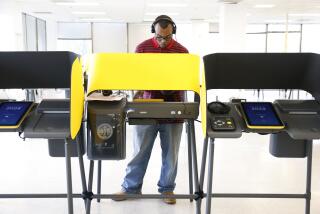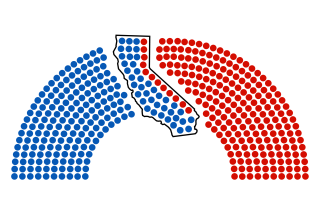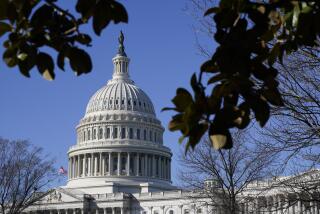Analysis: Why winning California’s presidential primary won’t be easy for Bernie Sanders

Democratic presidential candidate, Sen. Bernie Sanders of Vermont walks onstage with his wife, Jane O’Meara Sanders, at a rally March 23 in Los Angeles.
The Democratic presidential campaign arrived in California this week with a dynamic unaltered by the long battle through the South and Midwest: Bernie Sanders wins states that are predominantly white, and Hillary Clinton’s odds of victory escalate as states grow more diverse.
That suggests a difficult road ahead for Sanders in the nation’s largest state, where women and minorities — the groups among which Clinton is most powerful — dominate Democratic contests.
Both candidates were in California on Wednesday. Clinton, with an eye to the terrorist attacks that riveted the world Tuesday, delivered a speech at Stanford University on combating the Islamic State militant group. Sanders held a giant rally in San Diego on Tuesday night before traveling to Los Angeles for campaign events Wednesday that included another large gathering at the Wiltern Theater.
The contrast of the two schedules underscored the differences between the candidates as the presidential contest moves toward the June 7 primary here.
Sanders has the most visible support and is counting on the rush of enthusiasm for him, particularly among young and very liberal voters, who flock to his rallies, to break down the Clinton bulwark in California that has been built and sustained for a generation.
Clinton is counting on her support being the most durable, if not the flashiest. And while trying to tamp down Sanders’ momentum, she is also aiming most of her firepower at her most likely general election opponents, Republicans Donald Trump and Ted Cruz.
On Wednesday, during an interview with editors and editorial writers at the Los Angeles Times, Sanders acknowledged that he has only a “narrow path” to the nomination. After Tuesday’s primaries, he trails Clinton by more than 300 delegates in the race to win a majority for the nominating convention in July, not counting the more than 400 party leaders and other so-called super-delegates who have announced their support for her.
Winning in California forms an essential part of his remaining hope of defeating Clinton, Sanders said, adding: “You’re going to see me here more than you feel comfortable with.”
What Californians may not see is much effort by Clinton to criticize Sanders. In her speech at Stanford, Clinton did not mention her Democratic opponent, instead turning her focus to November and Trump and Cruz, whom she denounced in biting terms.
She cast Cruz’s proposal to bomb ISIS into submission as reckless and said Trump’s support for the use of torture against captured terrorists “puts our own troops, and increasingly our own civilians, at risk.”
“We need to rely on what actually works, not bluster that alienates our partners and doesn’t make us any safer,” Clinton said. Trump’s remarks this week, in which he cast doubt on future U.S. participation in NATO, would “reverse decades of bipartisan leadership and send a dangerous signal,” she added.
She also used the speech, delivered near the heart of Silicon Valley, to put the technology industry on notice that she expects more help in combating terrorism.
Throughout, she cast herself as the candidate best equipped — on either side — to stride into the Oval Office.
Early indications are that Clinton and Sanders could run a close race in California. That would not be good enough for the senator from Vermont, who needs to beat Clinton decisively here to overtake her lead in delegates.
A survey released Wednesday by the Public Policy Institute of California showed Clinton leading Sanders, 48% to 41%. She held a 23-percentage-point lead among Latinos, who could make up about a third of the Democratic electorate in June. Among women, who are more than half the Democratic vote, Clinton led by 19 percentage points.
Sanders has found great success this year in caucus states, where his supporters can overrun Clinton’s efforts. His victories Tuesday in the Idaho and Utah caucuses, where lines of his supporters snaked around buildings in a visible show of support, demonstrated what his campaign can do on a smaller scale.
But organizing a state with more than 7.4 million Democrats — and an additional 4.1 million nonpartisan voters who can cast Democratic ballots this year — is a giant exercise unlike any Sanders has pulled off in the campaign so far, as he conceded in Wednesday’s interview.
Essentially he is trying to do what Barack Obama could not do in his 2008 primary battle here with Clinton — and doing it without Obama’s strength among African American voters.
“Her coalition is very similar to what it was in 2008,” said Bill Burton, an Obama campaign aide in 2008 and now a California-based Clinton backer. “And she’ll probably do so much better than she did with African Americans, now that President Obama isn’t in the race.”
Arizona, where Clinton won on Tuesday, is a far smaller state than California, though its demographic makeup is somewhat similar. The results there were not good news for the Vermont senator — particularly if they are replicated to the west.
Sanders outspent Clinton down the stretch in Arizona and held rallies that drew thousands and inspired hope in the campaign for an upset. Clinton won by double digits.
Another troublesome predicate for a California race could be found in Ohio, where Clinton brushed aside Sanders’ challenge on the strength of alliances made decades ago and nurtured until this campaign — just as they have been here.
Clinton’s template for a win here will be what she pulled off in 2008, in what was then a February primary.
That year, she specifically targeted women in Northern California who were eager to elect the first female president and Latinas in Southern California rallied by the strongly female congressional delegation. She also leaned on a political structure developed since 1992, when Bill Clinton became the first Democrat to win the state in a general election in 28 years.
The one-two punch cut short the surge that Obama had ridden into the state. Her victory here enabled her to move on to the next states; ultimately she stayed in the race until the contests ended in June.
The makeup of the Democratic electorate has, if anything, moved more in Clinton’s direction in the last eight years as the numbers of Latino and Asian voters have grown. A Democratic voter profile created by Public Policy Institute of California pollsters last summer found that only 48% of Democratic voters were white, along with a slightly higher 55% of nonpartisan voters. Among Democrats, 26% were Latino, 13% were Asian and 10% were black.
Throughout the campaign, Clinton has amassed high percentages among minority voters, which has led to her wins in states as diverse as Nevada, Virginia and all the Southern states that have voted.
Election 2016 | Live coverage on Trail Guide | March 22 election results | Track the delegate race | Sign up for the newsletter
To expand his reach in California, Sanders will need to energize independent voters, who have proven more embracing of his message in other states. Those voters can cast ballots; the question for Sanders is whether they will, on a broad enough scale to offset Clinton’s strength among Democratic Party loyalists.
Sanders will also have to persuade Californians that his call for “political revolution” is the better of the two options. For all its reputation for liberalism, California tends to reward more mainstream candidates; the state’s governor, Jerry Brown, is practically conservative in many ways when his tenure is compared with the proposals put forth by Sanders and, increasingly, Clinton.
Much may be determined by the state of the race when it gets here. Right now, both candidates are in it for the long haul, even if Clinton holds a huge delegate lead.
Sanders insists he intends to stay in the race until the convention, and he has the money to do so. If the race is virtually locked up by June 7, however, he could find it more difficult to rally his troops.
In Wednesday’s interview, Sanders suggested an unconventional approach to success here, however: one not dependent on television ads, through which most political communication is accomplished in a state so large. He said he would mount a ground assault that will require tens of thousands of volunteers. He also will continue to hold the enormous rallies that have marked his campaign, both here and elsewhere.
Clinton can also be expected here a lot — either at campaign events or behind lushly appointed closed doors at fundraisers that her campaign typically holds in California, but whose scheduling has become even more important to offset Sanders’ massive fundraising operation.
One fundraiser is scheduled next month at the home of actor George Clooney and his wife, attorney Amal Clooney.
Also contributing were Christina Bellantoni in Los Angeles and Evan Halper in Washington.
Follow me on Twitter: @cathleendecker . For more on politics, go to latimes.com/decker.
ALSO:
Sanders on California: You’re going to see me here more than you feel comfortable with
Clinton takes on Trump and Cruz during counterterrorism address at Stanford
California’s June primary just became crucial in the race for the White House
Listen to Sanders at the L.A. Times editorial board
Updates on California politics
Live coverage from the campaign trail
More to Read
Get the L.A. Times Politics newsletter
Deeply reported insights into legislation, politics and policy from Sacramento, Washington and beyond. In your inbox three times per week.
You may occasionally receive promotional content from the Los Angeles Times.







